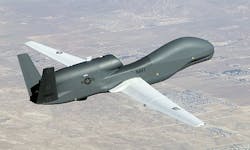Air Force asks Northrop Grumman to beef-up cyber security for BACN communications
Officials of the U.S. Air Force 653rd Electronic Systems Wing at Hanscom Air Force Base, Mass., announced a $6.9 million contract modification Friday to the Northrop Grumman Corp. Space Mission & Systems segment in San Diego to provide cyber security capability to the Air Force Battlefield Airborne Communications Node (BACN).
The contract calls for Northrop Grumman to meet cyber security requirements using the new Risk Management Framework of the U.S. Department of Defense (DOD).
The BACN is an electronic payload aboard the Air Force RQ-4 Global Hawk large unmanned aerial vehicle (UAV), as well as manned aircraft. The BACN uses the Airborne Executive Processor (AEP) to enable a persistent voice and data gateway in the sky that receives, bridges, and distributes communication among all participants in a battle.
The Risk Management Framework, managed by the U.S. National Institute of Standards and Technology (NIST) is designed to help organizations charged with providing the nation's military, financial, energy, health care, and other critical systems better protect their information and physical assets from cyber attack.
Related: Air Force asks Northrop Grumman to stiffen Global Hawk UAS defenses against cyber attacks
The framework provides a structure that organizations use to improve comprehensive cyber security programs. The framework provides a common language to manage cyber risk in a cost-effective way. Organizations use the framework to determine their current level of cyber security, set goals, and establish a plan for improving or maintaining cyber security.
The Battlefield Airborne Communications Node payload aboard the Global Hawk UAV helps enable diverse battlefield weapon systems to communicate with each other during in-theater operations where mountainous terrain, large buildings, or other obstructions inhibit line-of-sight communications.
Military leaders found that such obstructions could limit operating units to see only a limited set of the complete picture of the battlefield. The BACN is designed to provide situational awareness from small ground units in contact up to the highest command levels, Northrop Grumman officials say.
BACN’s AEP provides translator and gateway interfaces among all supported communications systems, and forwards intelligence information to the Global Information Grid. By controlling the AEP via a ground station, BACN is radio- and platform-agnostic, Northrop Grumman officials say.
On this contract Northrop Grumman will do the work in San Diego, and should be finished by this June. For more information contact Northrop Grumman Space & Mission Systems online at www.northropgrumman.com, or the 653rd Electronic Systems Wing at www.hanscom.af.mil.
About the Author
John Keller
Editor-in-Chief
John Keller is the Editor-in-Chief, Military & Aerospace Electronics Magazine--provides extensive coverage and analysis of enabling electronics and optoelectronic technologies in military, space and commercial aviation applications. John has been a member of the Military & Aerospace Electronics staff since 1989 and chief editor since 1995.
